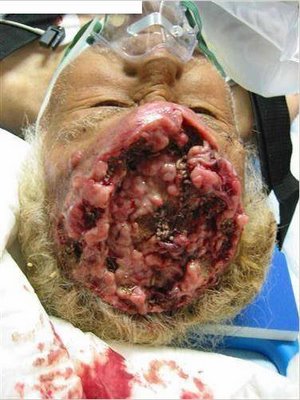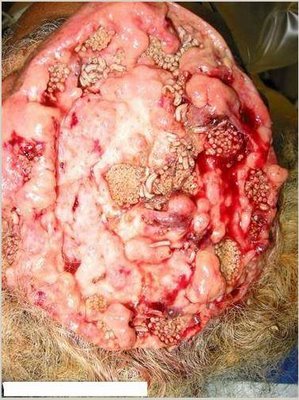1) Siamese Twins Ahmed and Mohamed Ibrahim
Anyone who watches the Discovery Health channel knows that nature likes to throw us a lot of genetic curveballs: Siamese twins, extra appendages, chimeras, hermaphrodites...you name it. But you haven't seen anything yet. The people in this article have some of the most startling, unimaginable birth defects the world has ever seen. Suddenly that annoying birthmark of yours doesn't look so bad.
2) Supatra "Nat" Sasuphan
"Wolf Girl"
She may look more like a furry animal than a little girl, but Thailand's Supatra "Nat" Sasuphan (dubbed "Wolf Girl") in fact has Ambras Syndrome (also known as congenital hypertrichosis), which causes excessive hair growth over the face and body.
The Daily Mail reports that only 40 people worldwide have been diagnosed with this unusual condition.
3) Milagros Cerron: Before and After surgery
"The Little Mermaid"
Lots of little girls dream about being a mermaid just like Ariel. But for Peruvian baby Milagros Cerron, being born with fused, mermaid-style legs was a nightmare. The precious tot was born with a condition called sirenomelia, more commonly known as mermaidism. According to
Channel4.com, the disorder strikes one in every 70,000-100,000 babies; those affected usually succumb to severe health defects and Milagros is only one of two known survivors. Dubbed "The Little Mermaid," she made headlines when doctors surgically separated her legs, and the
San Francisco Gate reports that three-year-old Milagros took her first unaided steps earlier this year.
Tiffany Yorks
Like Milagros Cerron, Tiffany Yorks was also born with sirenomelia, fused legs that resemble a mermaid's tail. According to
"Inside Edition," Tiffany is the first and oldest known survivor of the condition, though she has had her share of related ailments, including kidney and heart defects. Nineteen-year-old Tiffany has undergone more than 30 operations, and though her legs are now separate, knee ailments have left her in a wheelchair. Still, she hasn't forgotten her "mermaid" roots, telling the TV program that "When I'm under the water and I'm swimming I just feel free like there's no crutches, no wheelchair, no doctors, no needles, it's just me and the water."
4) "Cyclops Baby"
In a story straight out of Greek mythology, an Indian woman last year gave birth to a baby girl born with a single eye in the middle of the forehead-an extremely rare condition known as cyclopia. The baby was also born without a nose, and her brain was squeezed into only one hemisphere. According to Wired, doctors speculate that the severe birth defects were potentially caused by an experimental drug called Cyclopamine, which is used to fight cancer. The baby's mother had experienced fertility problems and may have been given the medicine-which gets its name from the one-eyed lambs that were born after a flock of sheep feasted on the toxin found within wild corn lily-as part of her treatment. Cyclopia can also arise when a mother has significantly low cholesterol or diabetes, Wired says.
5) Moises Chavez (center row left)

"Lobster Baby"
Peruvian infant Moises Chavez was dubbed "Lobster Baby" when he was born with four claw-like limbs that bend around his body-a rare condition known as arthrogryposis. According to
TheAge.com.au, about one in every 3,000 U.S. births features one limb suffering from this condition; that Chavez has it in all four is extremely unusual.
"Dark-haired Moises, who weighs 2.5kg and is 33cm long, cries and reacts to sound but his leg bones are bent at a 90-degree angle from his body, while his hands are distorted outward as his tiny elbows hug his chest,"
TheAge.com.au reports.
Surgeons were planning to operate on Moises's arms and legs to correct the problem.
6) Manar Maged

The tale of little Manar Maged is a heartbreaking one. The Egyptian girl was born with two heads, the result of a split embryo that should have resulted in a twin; the condition is called craniopague parasiticus. Maged's second head could smile and blink,
BBC News reports, but could not function on its own and it is unknown whether it had its own mental capacity. Sadly, Maged died at the age of two after contracting a brain infection.
7) The Khan Family

Birth defects are themselves extremely rare, but for multiple family members to be afflicted is almost unheard of. That makes the case of India's Khan family so bewildering. Four Khan children-including a sister who died of pneumonia at age 16-have been diagnosed with progeria, a condition which rapidly accelerates the aging process; most sufferers die by the time they reach their early twenties. According to a
BBC News report from 2005, this "is the only known example where more than one family member suffers from the disease." In fact, there are only 48 cases of progeria in the entire world.
The three surviving Khan children, Ali Hussein, Rehena, and Ikramul, have skin and teeth problems, look decades older than they are, have stunted development, and are susceptible to age-related diseases. Their parents do not have the disease, and they have two healthy siblings. Doctors have concluded that both Khan parents must be carriers of the progeria gene for this anomaly to have occurred.
8) Mandy Sellars
We all deal with a little cellulite here and there...but what if your legs weighed 11 stone (154 pounds)? Englishwoman Mandy Sellars looks like your typical trim 30-something woman from the waist up, but a disfiguring condition called Proteus Syndrome has caused her legs and feet to grow at an abnormal rate. According to
BBC News, Mandy's feet are 16 inches long and her legs measure 35 inches in diameter at the bottom.
Proteus Syndrome reportedly only affects 120 people in the world; "Elephant Man" John Merrick is thought to have had the condition, which triggers abnormal growth.
Mandy has been told that doctors may have to amputate her legs if they continue to grow, a possibility that doesn't seem to faze her.
"I have goals for when that does happen," she told the BBC. "Why not? It can be a different life. It could be a more adventurous life. Things I can't do now I might be able to do then. I quite fancy having a go at snowboarding actually, maybe paragliding or white water rafting would be wonderful, it really would."
9) Devendra Harne
Birth defects don't always mean compromised health or painful surgeries. In the case of India's Devendra Harne, his polydactylism condition earned him a place in the Guinness Book of World Records as the person with the most fingers and toes (25). That's 12 fingers and 13 toes, for those of you keeping track at home. According to
NagpurPlus.com, "The deformity is not a handicap for Devendra who is the kid next door and attends school regularly. Devendra also attend to his daily chores without any help and is an ideal student ... Devendra says he does not feel any difficulty in using the extra fingers."
10)Sarah Morrison

Precious Sarah Morrison is not quite a year old, but she's already suffered 30 rib fractures at birth and broken two bones at home. Little Sarah suffers from brittle bone disease (also known as osteogenesis imperfecta), and her hips and back must be supported at all times. This isn't the first time her parents have dealt with the disorder; their first baby, also a girl, had the same disease and died after two weeks. Doctors advised Sarah's mother to get an abortion, and expected that the baby would die after two days. Though the little girl has proven them wrong, she is "so delicate she can break a bone just by sneezing and can never be hugged by her parents," says
The Daily Mail.
11) Alamjan Nematilaev

Alamjan Nematilaev of Kazakhstan for the most part looked like any other boy his age, except for a distending stomach that made him appear pregnant.
TimesOnline.co.uk reports that when doctors noticed the then seven-year-old's bulging belly, they rushed him into surgery and removed a "large, rounded mass" that was covered in blood vessels. The mass stumped Alamjan's surgeons. "They saw dark hair, arms, fingers and even nails, legs, toes, genitals, a head, an approximation of a face,"
The Times reports. "They had no idea what it was."
The ultimate diagnosis: This was a foetus in foetu, a "rare condition in which twins are conceived from one egg but the twinning is unequal, and at an early stage of development the incomplete twin is enveloped by the normal one, living off it as a parasite."
Post-surgery, Alamjan is now a healthy and normal young boy. Rather than risk psychological trauma, Alamjan's parents told him that he had needed surgery because he had eaten bad fruit.
Source:-
Body Philosophy














